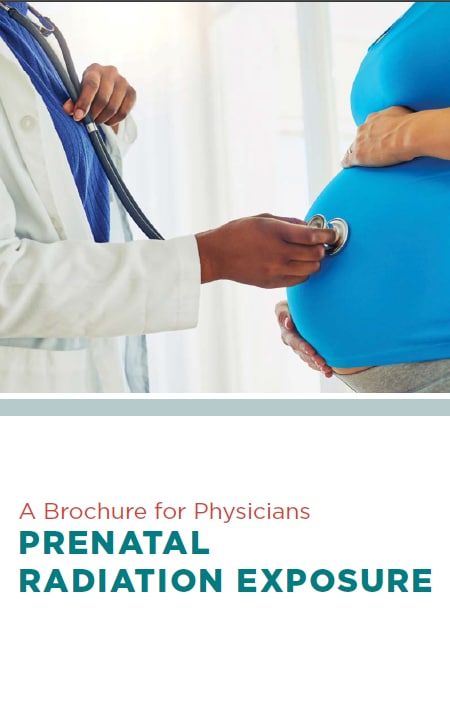Purpose
This page includes information about prenatal radiation exposure. It can be used as an aid in counseling someone who is pregnant.

How to use this document
This information is for clinicians. If you are a patient, we strongly advise that you consult with your physician to interpret the information provided, as it may not apply to you. Information for the public can be found on the Radiation Emergencies and Pregnancy page.
CDC recognizes that providing information and advice about radiation to expectant parents falls into the broader context of preventive healthcare counseling during prenatal care. In this setting, the purpose of the communication is always to promote health and long-term quality of life for the pregnant parent and child.
Radiation exposure to a fetus
Most of the ways someone who is pregnant may be exposed to radiation, such as from a diagnostic medical exam or an occupational exposure within regulatory limits, are not likely to cause health effects for a fetus. However, accidental or intentional exposure above regulatory limits may be cause for concern.
Although radiation doses to a fetus tend to be lower than the dose to the mother, due to protection from the uterus and surrounding tissues, the human embryo and fetus are sensitive to ionizing radiation at doses greater than 0.1 gray (Gy). Depending on the stage of fetal development, the health consequences of exposure at doses greater than 0.5 Gy can be severe, even if such a dose is too low to cause an immediate effect for the mother. The health consequences can include growth restriction, malformations, impaired brain function, and cancer.
Estimating the radiation dose to the embryo or fetus
Health effects to a fetus from radiation exposure depend largely on the radiation dose.
Estimating the radiation dose to the fetus requires consideration of all sources external and internal to the mother's body:
- Dose from an external source of radiation to the parent's abdomen
- Dose from inhaling or ingesting a radioactive substance that enters the bloodstream and that may pass through the placenta
- Dose from radioactive substances that may concentrate in maternal tissues surrounding the uterus, such as the bladder, which could irradiate the fetus
Most radioactive substances that reach the mother's blood can be detected in the fetus' blood. The concentration of the substance depends on its specific properties and the stage of fetal development. A few substances needed for fetal growth and development (such as iodine) can concentrate more in the fetus than in corresponding maternal tissue.
Consideration of the dose to specific fetal organs is important for substances that can localize in specific organs and tissues in the fetus, such as
- Iodine-131 or iodine-123 in the thyroid
- Iron-59 in the liver
- Gallium-67 in the spleen
- Strontium-90 and yttrium-90 in the skeleton
Estimating the radiation dose to the embryo or fetus
Hospital medical physicists and health physicists are good resources for expertise in estimating the radiation dose to the fetus. In addition to the hospital or clinic's specialized staff, physicians may access resources from or contact the following organizations for assistance in estimating fetal radiation dose:
- The National Council on Radiation Protection and Measurements' Report No. 174, "Preconception and Prenatal Radiation Exposure: Health Effects and Protective Guidance" [NCRP2013] provides detailed information for assessing fetal doses from internal uptakes.
- The International Commission on Radiological Protection's "Publication 84: Pregnancy and Medical Radiation" [ICRP2000] provides fetal dose estimations from medical exposures to pregnant women.
- The Conference of Radiation Control Program Directors maintains a list of state Radiation Control/Radiation Protection program contact information.
- The Health Physics Society maintains a list of active certified health physicists.
- The American Association of Physicists in Medicine provides information resources.
Once the fetal radiation dose is estimated, potential health effects can be assessed.
Potential health effects of prenatal radiation exposure (other than cancer)
Table 1 summarizes the potential non-cancer health risks of concern. This table is intended to help physicians advise pregnant people who may have been exposed to radiation, not as a definitive recommendation. The indicated doses and times post-conception are approximations.
Table 1: Potential health effects (other than cancer) of prenatal radiation exposure
| Acute Radiation Dose* to the Embryo/Fetus | Time Post Conception (up to 2 weeks) |
Time Post Conception (3rd to 5th weeks) |
Time Post Conception (6th to 13th weeks) |
Time Post Conception (14th to 23rd weeks) |
Time Post Conception (24th week to term) |
|---|---|---|---|---|---|
| <0.10 Gy (10 rads) |
Noncancer health effects NOT detectable | ||||
| 0.10–0.50 Gy (10–50 rads) | Failure to implant may increase slightly, but surviving embryos will probably have no significant (non-cancer) health effects. |
Growth restriction possible | Growth restriction possible | Noncancer health effects unlikely |
|
| > 0.50 Gy (50 rads) The expectant mother may be experiencing acute radiation syndrome in this range, depending on her whole-body dose. |
Failure to implant will likely be high, depending on dose, but surviving embryos will probably have no significant (non- cancer) health effects. |
Probability of miscarriage may increase, depending on dose.Probability of major malformations, such as neurological and motor deficiencies, increases.
Growth restriction is likely |
Probability of miscarriage may increase, depending on dose.Growth restriction is likely. | Probability of miscarriage may increase, depending on dose.Growth restriction is possible, depending on dose. (Less likely than during the 6th to 13th weeks post conception)
Probability of major malformations may increase |
Miscarriage and neonatal death may occur, depending on dose. § |
8th to 25th Weeks Post Conception:The most vulnerable period for intellectual disability is 8th to 15th weeks post conceptionSevere intellectual disability is possible during this period at doses > 0.5 GyPrevalence of intellectual disability (IQ<70) is 40% after an exposure of 1 Gy from 8th to 15th weekPrevalence of intellectual disability (IQ<70) is 15% after an exposure of 1 Gy from 16th to 25th week
Note: This table is intended only as a guide. The indicated doses and times post conception are approximations.
Gestational age and radiation dose
During the first 2 weeks post-conception, the health effect of concern from an exposure of ≥ 0.1 Gy is the possibility of death of the embryo. Because the embryo is made up of only a few cells, damage to one cell, the progenitor of many other cells, may cause the death of the embryo, and the blastocyst may fail to implant in the uterus. Embryos that survive, however, are unlikely to exhibit congenital abnormalities or other non-cancer health effects, no matter what dose of radiation they received.
In all stages post-conception, radiation-induced non-cancer health effects are not detectable for fetal doses below about 0.10 Gy.
Carcinogenic effects of prenatal radiation exposure
Radiation exposure to an embryo/fetus may increase the risk of cancer in the offspring, especially at radiation doses > 0.1 Gy, which are well above typical doses received in diagnostic radiology. However, attempting to quantify cancer risks from prenatal radiation exposure presents many challenges. These challenges include the following:
- The primary data for the risk of developing cancer from prenatal exposure to radiation come from the lifespan study of the Japanese atomic bomb (A-bomb) survivors [Preston et al. 2008]. The analysis of that cohort includes cancer incidence data only up to the age of 50 years. This precludes making lifespan risk estimates as a result of prenatal radiation exposure.
- From the Japanese lifespan study [Preston et al. 2008], it can be concluded that for those exposed in early childhood (birth to age 5 years), the theoretical risk of an adult-onset cancer by age 50 is approximately ten-fold greater than the risk for those who received prenatal exposure. Therefore, the risk following prenatal exposure may be considerably lower than for radiation exposure in early childhood [NCRP2013].
- No reliable epidemiological data are available from studies to determine which stage of pregnancy is the most sensitive for radiation-induced cancer in the offspring [NCRP2013].
The lifespan study of the Japanese A-bomb survivors is continuing as the cohort ages. Future analyses of the accumulating data should provide a better understanding of the lifetime risk of cancer from prenatal and early childhood radiation exposure.
More information
- Radiation Emergency Assistance Center/Training Site
- Radiation Emergency Medical Management (REMM)
- Conference of Radiation Control Program Directors
- Health Physics Society
- International Commission on Radiological Protection
- National Council on Radiation Protection and Measurements
- American Association of Physicists in Medicine
Table 1 footnotes
* Acute dose: dose delivered in a short time (usually minutes). Fractionated or chronic doses: doses delivered over time. For fractionated or chronic doses, the health effects to the fetus may differ from what is depicted here.
† Both the gray (Gy) and the rad are units of absorbed dose and reflect the amount of energy deposited into a mass of tissue (1 Gy = 100 rads). In this document, the absorbed dose is that dose received by the entire fetus (whole-body fetal dose). The referenced absorbed dose levels in this document are assumed to be from beta, gamma, or x-radiation.
§ For adults, the LD50/60 (the dose necessary to kill 50% of the exposed population in 60 days) is about 3-5 Gy (300-500 rads) and the LD100 (the dose necessary to kill 100% of the exposed population) is around 10 Gy (1000 rads).
Table adapted from Table 1.1. of the National Council on Radiation Protection and Measurements’ Report No. 174, “Preconception and Prenatal Radiation Exposure: Health Effects and Protective Guidance” [NCRP2013].
- [ICRP2000] International Commission on Radiological Protection. 2000. Valentin, J. (2000). Pregnancy and medical radiation. Oxford: Published for the International Commission on Radiological Protection.
- [NCRP2013] National Council on Radiation Protection and Measurements. 2013. Preconception and Prenatal Radiation Exposure Health Effects and Protective Guidance. (2013). Bethesda: National Council on Radiation Protection & Measurements.
- Preston DL, Cullings H, Suyama A, Funamoto S, Nishi N, Soda M, Mabuchi K, Kodama K, Kasagi F, Shore RE. 2008. Solid cancer incidence in atomic bomb survivors exposed in utero or as young children. J Natl Cancer Inst 100(6):428-436.
- [UNSCEAR2013] United Nations Scientific Committee on the Effects of Atomic Radiation. 2013. Sources, effects and risks of ionizing radiation. Vol. II, Scientific Annex B: Effects of radiation exposure of children.

